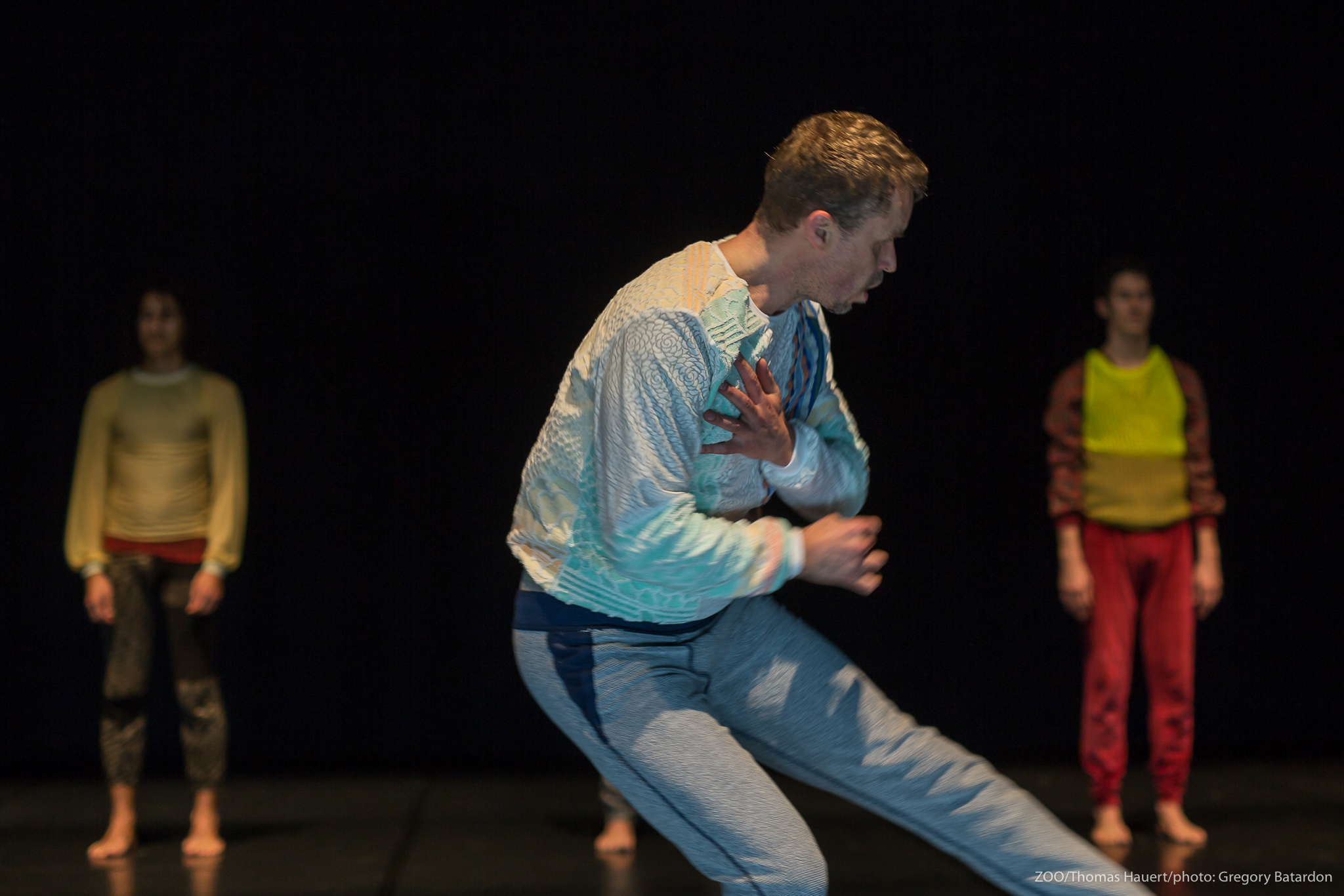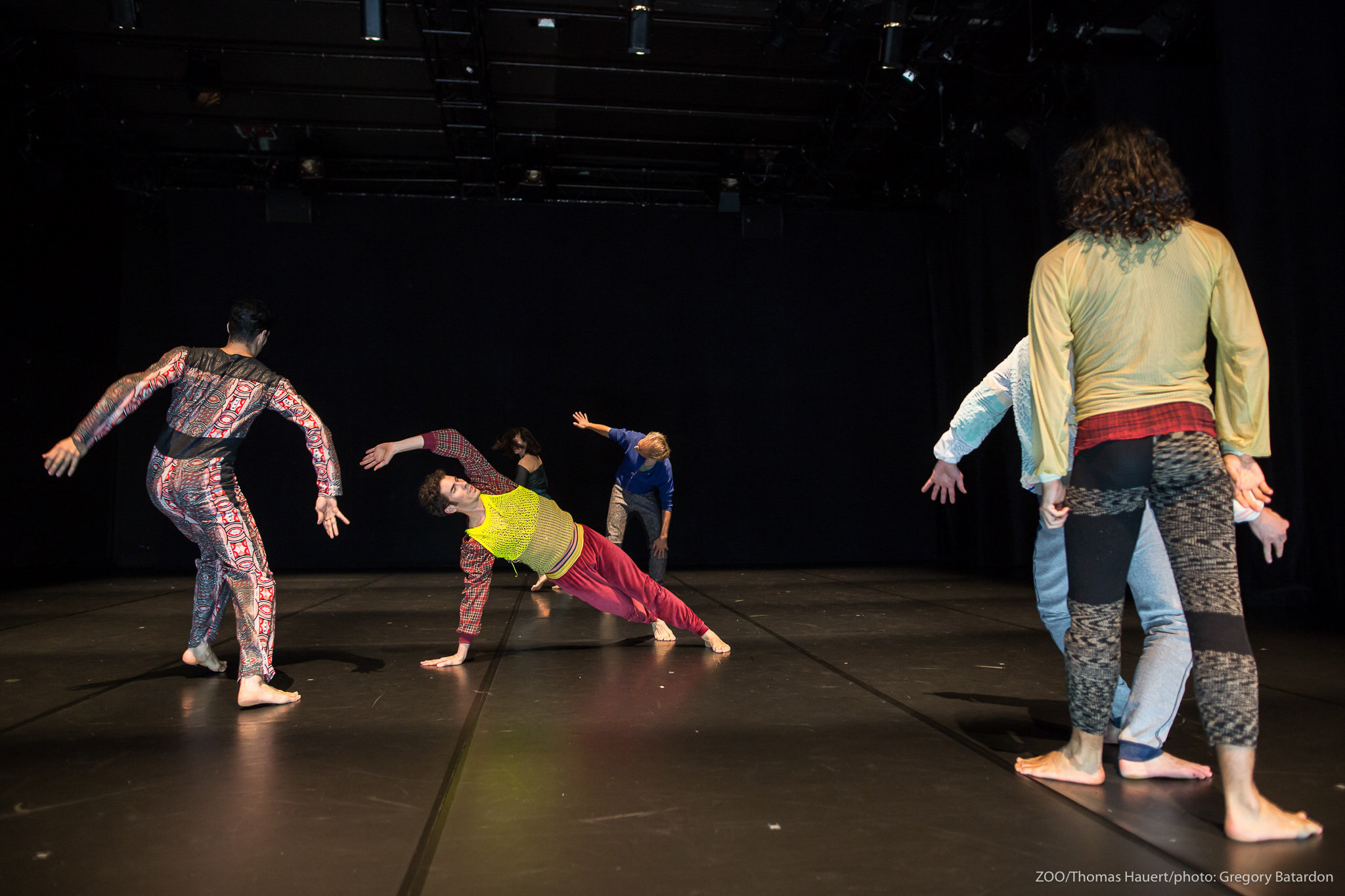
inaudible
In this new group piece for six dancers, Thomas Hauert focuses on the notion of “interpretation”. By deconstructing codes and cultural layers, inaudible offers a game between highbrow art and popular culture, between direct seduction and deceiving expectations that makes the choreographer’s language accessible yet unpredictable (Swiss Dance Award 2017).
Gershwin
After experimenting in the studio during the creation of his solo (sweet) (bitter), in which different interpretations of Monteverdi’s madrigal Si Dolce è’l Tormento entered into dialogue with the dance and excerpts from Salvatore Sciarrino’s 12 Madrigali, for inaudible Thomas has chosen to work with the score of Concerto in F written by the American composer George Gershwin in 1925. Gershwin’s work occupies a singular position in the history of music. In conflict with modernist and purist trends, he ingeniously undertook the fusion of different musical worlds – Broadway, music hall, jazz, Klezmer and classical. Often snubbed by the guardians of the hierarchies of Eurocentric high culture, Gershwin cared little about taboos and insolently went against the laws of good taste imposed by the cultural establishment.
Concerto in F is a fascinating work musically: both familiar and surprising, the richness of the score conveys a contagious energy. It unleashes a radiating optimism; it is a luminous world of sound, a sort of utopia. It is a music that generates movement and enters into the listener’s body; it is a very dancy music, a music that “makes you move”. This physical phenomenon interests Thomas Hauert: the physicality of the music itself that invades our bodies. Gershwin’s music can be heard on a purely abstract level, removed from all references and narrative associations that are attached to the Gershwinian sound, due among other things to Hollywood’s use of it in countless soundtracks. Gershwin himself wanted the listener to perceive of this concerto as abstract music. As he was creating the work, he changed its original title from New York Concerto to Concerto in F to avoid the suggestion of a narrative. The abstract musical material offers an abundance of rhythms, melodies, harmonies, counterpoints, phrases etc. that can generate choreographic impetus. It allows/causes/demands huge formal freedom in terms of the body’s vocabulary and interactions within the group.
Lanza
In resonance with Concerto in F, the choreographer has opted to work with a piece by the contemporary composer Mauro Lanza: Ludus de Morte Regis commissioned and performed by Les Cris de Paris (direction Geoffroy Jourdain). A composition for 28 singers, toys and electronics, it enters into a dialogue with Gershwin’s music. Contemporary music rarely has an immediate relationship with the body, but Mauro Lanza’s music is an exception: erudite and sensual at the same time, of dazzling depth and full of humour, it bridges the gap between several antagonists.
Mickeymousing
In the film world, the term “Mickey-Mousing” is used to describe film music that emphasises each physical movement in the action. We also use this term in dance, but to describe the opposite practice of movement following the music directly. This slightly derogatory term for it pays homage to the musical style of the cartoons of Mickey Mouse and others, a musical style born from the contribution of composers such as George Gershwin in the 1920s and 1930s with the advent of the talkies. The choreographer explores this phenomenon in inaudible. While the practice carries a rather pejorative image in the world of contemporary dance, it also creates public fascination for popular dances – hip-hop for example – which can be seen in the many posts on YouTube or on TV shows. Choreographed and coordinated with the music down to the tiniest detail, these dances perpetuate a choreographic tradition still found in popular culture based on the perception of the intrinsic unity between dance and music.
In inaudible, a large part of the movement proposed is improvised using a set of rigorously defined and often superimposed movement scores. The dancers have thoroughly absorbed the musical composition. They know it by heart in all its complexity: the individual melodic and rhythmic lines of each of its instruments all the way to the interactions of groups of instruments or soloists, as well as the alchemy of sound produced by the full orchestra. The incorporation and interpretation of all the events in a symphony orchestra by a single body is one of the central ideas that can be found in this creation.
Music is the driver of the dance here. By playing with time, space, forces and the bodies, the dancers launch themselves in search of creative, sophisticated and surprising ways to receive the music directly into their body. Keeping the power of immediate recognition from Mickey-Mousing, they redirect the audience’s expectations with their physical inventiveness, which unites intuition and consciousness through improvisation. The choreographic structures appear in dancing and in playing. Recognising the potential of events, the dancers can continually reinforce or transform these structures. The dance itself is not fixed in advance; no pre-existing form is being recreated. However the dancers continuously negotiate their trajectories and co-ordinations in relation to the music and the other dancers, according to a set of known and practised parameters. A little like in a football match, the game takes place according to certain rules but the trajectories, the events, the interactions are different with each game.
Also in inaudible one can detect a permutation of authority, of hierarchy: the choreography comes to existence through a joint creative effort. It integrates the creative potential – conscious and intuitive – of each dancer as well as their situation on stage, their subjective perspective on events as they happen. Their interpretation of the situation and their reactive intuition are linked to their individual subjective experience, to their personal story. At the same time, they act in an intention to create links with the others, with the music, in the space and time. They can act and react in consonance with the reality such as it is in the present, rather than following a premeditated plan. Resulting from this are a complexity and fluidity that are impossible to conceive of in advance, as well as a very particular presence and concentration.
Concept & direction Thomas Hauert
Created & performed by Thomas Hauert, Fabian Barba, Liz Kinoshita, Albert Quesada, Gabriel Schenker, Mat Voorter
Music George Gerswhin Piano Concerto in F, Mauro Lanza Ludus de Morte Regis
Musical collage Thomas Hauert
Costumes Chevalier-Masson
Light Bert Van Dijck
Sound Bart Celis
Informatical musical collaboration Ircam Martin Antiphon
Production ZOO/Thomas Hauert
Coproduction Kunstenfestivaldesarts (BE) / Charleroi danse (BE) / PACT Zollverein (DE) / La Bâtie – Geneva Festival(CH) / Centre chorégraphique national de Rillieux-la-Pape – direction Yuval Pick (FR) / Théâtre Sévelin 36,(CH) / CDC Atelier de Paris-Carolyn Carlson (FR) / Ircam – Centre Pompidou (FR)
With the support of Fédération Wallonie-Bruxelles – Service de la danse / Pro Helvetia – Fondation suisse pour les arts / Loterie Nationale / Vlaamse Gemeenschapscommissie / Ein Kulturengagement des Lotterie-Fonds des Kantons Solothurn / Wallonie-Bruxelles International
Studio Charleroi danse, La Raffinerie (BE) / Grand Studio (BE) / Centre chorégraphique national de Rillieux-la-Pape – direction Yuval Pick (FR)
Thanks Les Cris de Paris (direction Geoffroy Jourdain), who commissioned and performed Ludus de Morte Regis from Mauro Lanza in festival ManiFeste (Ircam – Centre Pompidou), 2013





